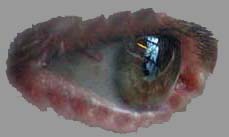Journal, May 24, 2006 (edited June 7, 2006)—Gaza
Photos: Gaza-6
Other photos and writing
Dispatches from Gaza - 6
(Water—Rafah & Khan Yunis)
By Skip Schiel
A foggy beginning of the day, most unusual in my short experience here. The wind direction seems to shift from off the water in the evening to toward the water in the morning. West to east, then the reverse.
This morning I meet the car at 8:30 for an early start at the American Friends Service Committee. So I probably do not have my usual freedom to write and write in my journal. A pity because this is proving to be one of the greatest benefits of the trip—truly free writing and photographing.
For a 3rd day, yesterday Amani brought herself and me on a water tour, this time south, all the way to Rafah, Khan Yunis, and the 2 southern border crossings. I could title my series from this Gaza journey, Arez to Rafah. Altho I'd asked to visit the site of Rachel Corrie's martyrdom, we didn't reach that point but did stop by the Rachel Corrie kindergarten in the same neighborhood. Kids were not around, but the playground was, and adjoining it was the shell of a sports court that had suffered from Israeli bombardment.
I learned later that "On several occasions, she and other International Solidarity Movement volunteers successfully prevented Israeli tanks from killing Rafah water officials as they repaired the Tel e-Sultan wells which the Israeli military has repeatedly tried to destroy." (Morgan Guyton, Counterpunch March 18, 2003) One major impression I've received on these tours is how destructive Israel was, both during the settlement period and while withdrawing. And continues to be. They deserve credit for leaving intact the roads, greenhouses, and some institutional buildings like schools. They deserve condemnation for leveling orchards and destroying a new port under construction south of Gaza, some roads, many homes that blocked their view of Palestinians, and their own water treatment plants that might have served Gazans, and other elements of civil life in the strip. This destruction, often illogical and seeming purely vindictive, occurred during the settlement times and during withdrawal. One way of telling this story might be to make a timeline of destruction.
Some of the settlements were near the seacoast but none were on it. So to get to the water, Israelis built roads and protected them, blocking all Palestine access, forcing longer routes for Gazans. Before the disengagement, simply getting from Gaza City to Rafah was a chore, now it is a breeze. Our drive time was about 40 minutes, with stops for visits.
Most of the demolition wreckage, roads and buildings, has been removed and the sites rebuilt. In places, usually at the municipal dumpsites, there are mounds of construction debris, the remains of homes. Not all roads have been rebuilt, the coastal route for one, has a missing section. This is like an outdoor museum, allowing all to view and experience the carnage of Israeli occupation and wrath.
On this tour a few sites stand out: the Rafah civil border crossing, a mass of folks, many seemingly with nothing to do but stand or sit around, armed men, some Hamas presumably, some Fatah, always ready to shoot at each other, many taxis of course, a few trucks. And one lone boy on a bike who I happened to catch when I put the camera to the earth to snap one last image for Amani. She'd wanted photos of the overall scene at the crossing, telling me they had many from the other side, and warning me—don't stray from us and don't take too long.
Which is another impression or feature of this water touring: Hurry! Yella ! Get moving! Many of my photos are truly snaps, not really composed, caught on the fly, sometimes from our moving car. At times, like at Rafah, danger precluded being more leisurely: at times, I felt the press of time, getting back for some other duty, as was true yesterday when I'd snatched the morning from promised time with AFSC to go on this very special southern journey.
Rarely did we visit sites of water supply or transport. We did see a small-scale desalination station providing free water to people who brought their own containers for fill up. Pumped from the municipal well, the water was suitable for agriculture, but with reverse osmosis, it is drinkable. Amani wanted me to photograph water tankers, but the few we saw were moving too fast, or we were, for a good photo. Otherwise, it was all sewage. Smelly and potentially lethal. What a pity to treat water this way, disrespectful to say the least.
The Rafah wastewater is only put thru settlement ponds, nothing else, before being routed into the sea. And this is an improvement over the method in Khan Yunis' disposal: straight from the source, out a black hose from the house, and free to run thru the street into the nearest wadi. This we saw on our last stop, a wadi emptying into an unlined pit, then leaching into the aquifer. The Palestine Water Authority is at work trying to correct this, but with the snarls I've listed before—low funding, blocked materials and equipment at Karni checkpoint, isolated personnel, and community opposition, plus the generally dangerous security situation—little is achieved.
This must be so frustrating for people like engineers. Aren't engineers trained to be efficient, to design and implement projects, to produce facts on the ground that they can say they've built?
—Gaza, May 24, 2006
LINKS
"The Right To Water in Palestine: Crisis in Gaza"
"The Settlers are Gone, The Polluted Water Remains," Amira Hass, August 2005 "How Will We Honor Rachel Corrie?
Nonviolence Must Triumph Over Tragedy," Morgan Guyton, March 18, 2003
"Nothing Ends Here. This is the End.
Nightmare in Rafah" Ben Granby, March 7, 2003
"Geologists call for desalination of Gaza Strip's water," Betsy Mason, November 2003
Reverse osmosis water purification |


